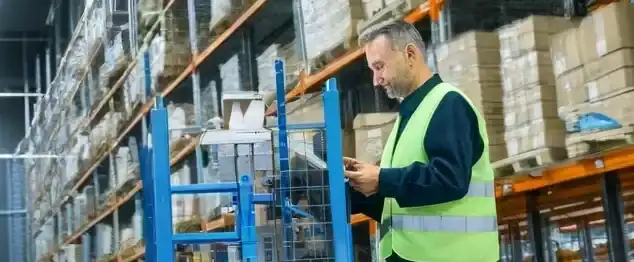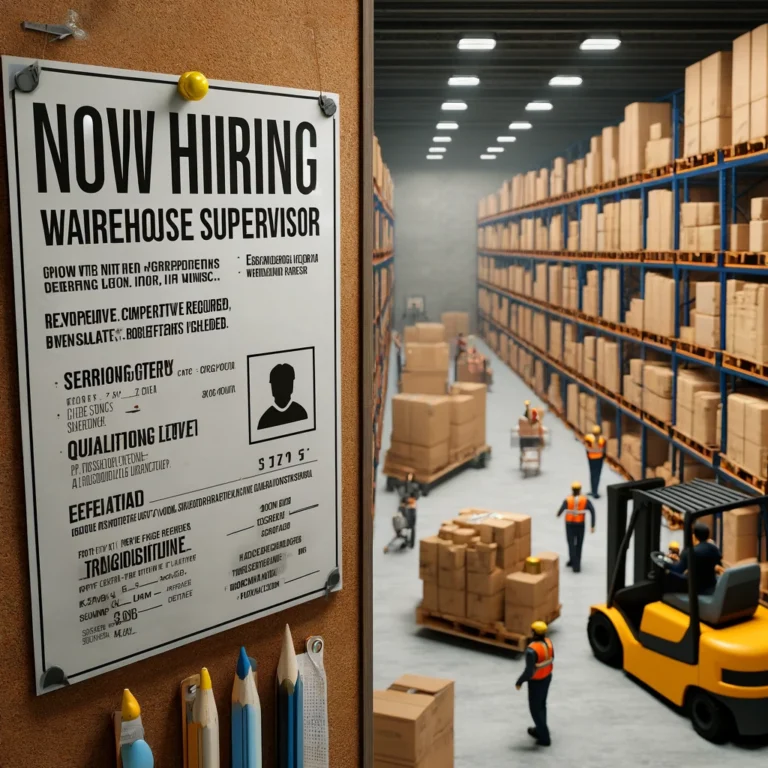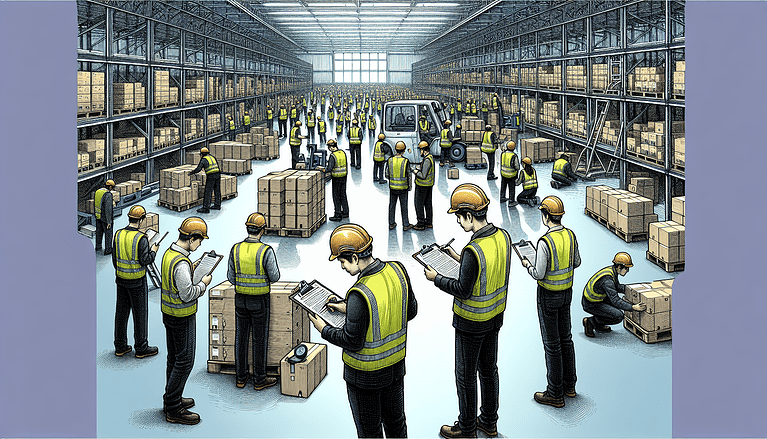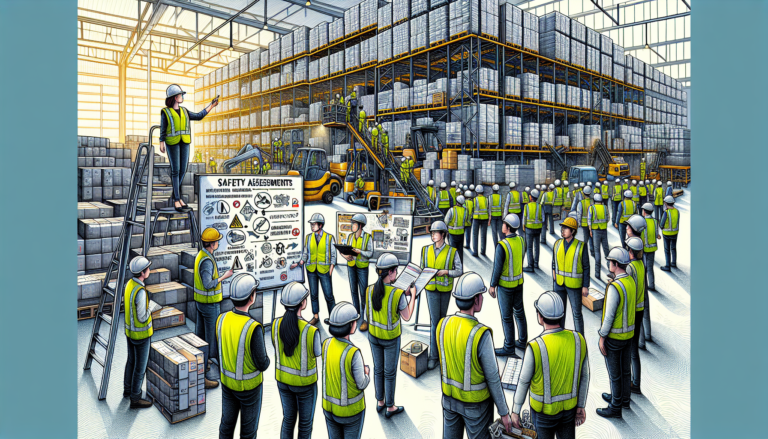The Powerful Guide to Warehouse Associates for 2025
Are you maximizing the potential of your warehouse associates? From organizing inventory to ensuring every safety protocol is met, your warehouse’s success hinges on the effectiveness of its crew.
Table of Contents

Key Takeaways:
Warehouse Organization is Crucial: An efficiently organized warehouse boosts workflow, enhances safety, and reduces operational costs by ensuring that high-turnover items are accessible and the space is utilized effectively.
Safety is Paramount: Implementing robust safety protocols, including the use of personal fall arrest systems and conducting regular safety audits, is essential to prevent accidents and maintain a safe working environment.
Cultivating a Safety-First Culture: Developing a strong safety culture within the warehouse through regular training, safety meetings, and employee involvement initiatives significantly reduces risks and enhances employee morale.
Role of Management and Training: Effective management is vital for the smooth operation of warehouse activities, and ongoing training for warehouse associates is crucial for operational efficiency and safety. Training programs should be comprehensive, covering everything from basic operational procedures to advanced safety protocols.
Importance of Specialized Roles: Distinct roles like Warehouse Supervisor and Safety Supervisor are critical, with each having specific responsibilities that ensure the warehouse operates efficiently and safely. Proper qualifications, skills, and continuous training for these positions are fundamental.
Regular Audits and Safety Committees: Conducting regular safety audits and having an active safety committee are advanced safety measures that help maintain high safety standards. These practices ensure compliance, improve response to safety issues, and foster proactive safety management.
Impact of Training on Efficiency and Safety: Training not only improves the skills and knowledge of warehouse associates but also directly impacts the safety and efficiency of warehouse operations, reducing workplace incidents and increasing productivity.
Employee Development and Retention: Investing in the professional development of warehouse associates leads to higher job satisfaction, better job performance, and lower employee turnover rates.
The role of associates is critical in a bustling environment. They are the backbone of day-to-day operations and the first line of defense in maintaining safety and efficiency standards.
This introductory guide reviews the multifaceted aspects of the job, from the foundational organization of goods to advanced safety measures and professional training.
By elevating the skills and knowledge of associates, companies can see marked improvements in operational flow and reduced incident rates.
Whether you’re a warehouse manager or new to the industry, understanding these key areas will help you create a safer, more efficient workspace.
Note: This is an introductory post to the topics below. For a more detailed explanation of each topic, I followed the links.
The Foundation of Warehouse Efficiency

Warehouse Organization
The organization within a warehouse is not merely about keeping things tidy; it’s about optimizing workflows and maximizing efficiency.
An organized warehouse layout ensures that goods are accessible, inventory is easily tracked, and space is utilized effectively.
This level of organization minimizes the time spent on locating and moving items, which can significantly reduce costs and improve delivery times.
An efficient layout also contributes to safety by reducing the chances of accidents caused by cluttered spaces or improperly stored items.
Furthermore, a well-organized warehouse boosts morale among staff, as they can perform their duties more effectively without unnecessary hindrances.
Tips for Maintaining an Efficient Warehouse Structure
Implement a Logical Layout: Arrange products based on frequency of access. Place high-turnover items near the packing and shipping areas to minimize movement and speed up processes. Encourage excellent time management.
Use Vertical Space: Maximize the use of vertical space with appropriate shelving and stacking strategies. This increases storage capacity and keeps the floor space less congested.
Adopt Lean Inventory Techniques: Use systems like Just-in-Time (JIT) to keep inventory levels low and reduce holding costs. This approach encourages better organization as there is less stock to manage.
Regular Audits and Reorganization: Conduct regular audits to ensure optimal layout as inventory and demands change. Adjust layouts and processes in response to these audits.
Leverage Technology: Invest in warehouse management systems (WMS) and automation tools that streamline inventory management and order fulfillment processes.
Role of Management in Defining Associate Responsibilities
Management plays a pivotal role in a warehouse’s functions. Leaders oversee the daily operations and set the strategic direction for the warehouse associate.
They are responsible for integrating new technologies, managing the workforce, ensuring compliance with safety standards, and improving overall efficiency. Good management practices directly influence productivity, employee satisfaction, and profitability.
Additionally, effective management is crucial in developing successful associates by fostering hard-working, organized, and detail-oriented qualities, which are essential for maintaining steady inventory levels and ensuring good record-keeping.

Strategies for Effective Warehouse Management
Clear Communication: Establish clear communication channels at all operations levels. Regular briefings and updates keep everyone informed and ensure that operations run smoothly.
Invest in Training: Equip your managers and staff with the latest best practices in management through ongoing training and professional development opportunities. Provide the appropriate tools and inventory controls for their success.
Implement Key Performance Indicators (KPIs): Measure the effectiveness of different areas of operations with KPIs tailored to specific goals like reducing waste, improving turnaround times, or increasing accuracy in inventory.
Encourage Feedback and Innovation: Create a culture where warehouse workers are encouraged to suggest improvements at all levels. This can lead to innovative practices that streamline operations and promote successful warehouse associate responsibilities.
Regularly Review and Optimize Operations: Continuously assess and refine workflows, employee productivity, and technology use to adapt to new challenges and changes in the market environment.
Crafting a Precise Job Description: A detailed job description is crucial in attracting qualified candidates for the role of Warehouse Associate. It serves as a foundation for outlining the responsibilities, skills, and qualifications needed, acting as a template to ensure only the best candidates are considered for the position.
By focusing on these aspects of organization and management, businesses can create a robust foundation for efficiency and collaboration among warehouse associates.
Warehouse Safety

General Warehouse Safety Practices
Safety is pivotal to employees’ well-being and operations’ productivity. General safety practices encompass many protocols designed to prevent accidents and injuries.
These include proper signage, clear walkways, and enforcing the use of safety gear, such as helmets, gloves, and safety shoes.
Regular safety drills and training sessions ensure that all staff know how to act in emergencies, such as fires or chemical spills. Furthermore, the maintenance of equipment and machinery is critical to prevent malfunctions that could lead to accidents.
Common Hazards and How to Avoid Them
Slips, Trips, and Falls: Keep all walkways clear of debris and promptly clean all spills. Ensure good lighting throughout the warehouse.
Falling Objects: Use secure shelving and storage systems, and never overload them. Store heavy items on lower shelves to reduce impact risk.
Forklift Accidents: Ensure all operators are properly trained and certified. Establish and enforce traffic rules within the warehouse.
Manual Handling Injuries: Train staff on proper lifting techniques. Provide tools such as forklifts, dollies, and carts to help move heavy items.
Hazardous Material Spills: Properly label and store all hazardous materials. Train employees on handling procedures and emergency response.
Personal Fall Arrest Systems (PFAS) are essential safety devices designed to stop a person from hitting the ground or a lower level in the event of a fall.
These systems typically consist of a full-body harness, a connection (such as a lanyard), and an anchor point. They are crucial for working from heights, such as stacking items on high shelves or performing maintenance on elevated machinery.

How These Systems Protect Warehouse Associates
PFAS are life-saving tools that protect employees by distributing the force of the fall across the body, significantly reducing the risk of severe injury. The system is designed to arrest the fall quickly and safely, minimizing the distance an individual falls. Regular inspections and maintenance of PFAS are critical to ensure their effectiveness and reliability in preventing fall-related injuries.
Creating a Warehouse Safety Culture

A strong safety culture is the cornerstone of a secure and efficient warehouse. It involves more than just following protocols; it’s about creating an environment where everyone is responsible for safety. A robust safety culture reduces accidents, enhances employee morale, and increases productivity, as workers feel secure and valued.
Examples of Safety Culture Initiatives
Regular Safety Meetings and Training: Hold frequent discussions and training sessions on safety topics to keep safety at the forefront of everyone’s mind.
Recognition Programs: Implement programs to recognize and reward employees for exemplary safety practices or for identifying safety hazards.
Safety Surveys: Regularly conduct anonymous surveys to gather feedback on the safety environment and identify areas for improvement.
Involve employees in Safety Decisions: Involving employees in safety planning and policy-making processes can increase compliance and enthusiasm for safety initiatives.
Continuous Improvement Programs: Encourage a policy of ongoing safety reviews and improvements, where employees at all levels are invited to suggest better safety practices.
By integrating these safety practices and culture initiatives, a warehouse safeguards its workforce and establishes a foundation for sustained operational success.
Safety Audits
Safety audits are systematic assessments to determine whether safety and health regulations are followed in the warehouse environment.
These audits thoroughly review all operational areas, safety protocols, and compliance with legal standards.
The primary goals are identifying potential hazards, assessing risk levels, and ensuring that all safety measures are up-to-date and effective.
Safety audits are crucial because they help prevent accidents before they occur. By proactively identifying issues and non-compliance, warehouses can rectify problems that could lead to injuries or more severe consequences.
Additionally, regular audits reinforce the importance of safety and ensure continuous improvement in safety management practices.
How Regular Audits Improve Safety Standards
Regular safety audits contribute to a safer environment by:
Identifying Recurrent Safety Issues: Audits help spot trends in safety violations or recurring hazards, which can be systematically addressed.
Ensuring Compliance with Safety Regulations: Frequent audits keep the warehouse in line with the latest safety laws and regulations, helping to avoid legal repercussions and fines.
Enhancing Employee Training: Audits often reveal gaps in employee safety training, prompting updates and refinements to training programs.
Improving Safety Equipment and Procedures: Regular reviews lead to updates in safety equipment and the evolution of safety procedures as new risks and technologies emerge.
Building Safety Awareness: Regular audits keep safety at the forefront of operational priorities and foster a culture that values and prioritizes worker safety.
Safety Committee

A safety committee is a group of workers and management who work together to improve workplace safety and health conditions. This committee is critical in bridging the gap between employees and management regarding safety issues. Responsibilities of a safety committee typically include:
Conducting Regular Safety Inspections: To identify and report potential hazards that might not be evident during less frequent audits.
Reviewing Accident Reports: To analyze incidents and near-misses, identify their causes, and recommend preventative measures.
Developing Safety Policies and Programs: To create or update safety protocols and ensure they are communicated effectively to all employees.
Promoting Safety Training: To organize ongoing safety education and training sessions for all staff members.
How a Safety Committee Enhances Workplace Safety
Safety committees enhance workplace safety by:
Facilitating Direct Employee Involvement: Allowing employees to have a say in safety matters ensures that their concerns are heard and addressed, which can increase compliance with safety practices.
Improving Response Times: Committees can act swiftly to address safety issues as they arise rather than waiting for formal audits or management decisions.
Increasing Safety Visibility: Regular meetings and communications from the safety committee keep safety visible and important to all employees.
Encouraging a Proactive Approach to Safety: By involving diverse workforce members, safety committees foster a proactive approach to identifying and solving safety problems before they lead to accidents.
By implementing these advanced safety measures, warehouses can significantly enhance their safety standards, providing a secure environment for their associates and ensuring efficient operations free from disruptive incidents.
Professional Development and Training
Training is a cornerstone of operational efficiency and safety in the warehouse setting. Effective training programs are designed to meet the needs of various roles within the warehouse, including:
Onboarding Training: For new employees, covering basic operations, safety protocols, and company policies.
Safety Training: Focused on specific safety practices, use of personal protective equipment, emergency procedures, and proper handling of hazardous materials.
Skill Development Training: Targeted at improving specific skills like forklift operation, inventory management, and order-picking techniques.
Leadership Training: This training is for potential or current warehouse leaders and focuses on management skills, conflict resolution, and effective supervision.
To further enhance the effectiveness of these programs, it’s crucial to incorporate the roles and responsibilities from the job description, ensuring that training aligns with the specific duties and expectations outlined for workers.
Impact of Training on Operational Efficiency and Safety

Training not only boosts the competence and confidence of associates but also directly impacts the efficiency and safety of operations:
Reduces Incidents and Accidents: Well-trained employees are less likely to engage in unsafe practices, reducing the likelihood of workplace accidents.
Increases Productivity: Training enhances the skills and speed at which employees can perform their tasks, leading to faster throughput and increased efficiency.
Improves Morale and Retention: Employees who receive training tend to feel more valued by their employer, which can improve morale and reduce turnover rates.
Warehouse Management Job Description
Utilizing a job description template can significantly streamline the process of creating effective warehouse worker job descriptions.
This approach saves time and helps attract qualified candidates and hire the best employees by providing detailed duties, responsibilities, and qualifications for roles such as Warehouse Supervisor and Safety Supervisor.
A well-crafted warehouse worker job description is essential for standing out and drawing in the right talent.
Warehouse Supervisor: This role focuses on overseeing the day-to-day operations within the operation, managing staff, optimizing workflow, and ensuring that targets and deadlines are met. The warehouse supervisor maintains operational efficiency and ensures processes run smoothly.
Safety Supervisor: This role is specialized in overseeing all aspects of workplace safety. The safety supervisor is responsible for implementing safety protocols, conducting safety audits, and leading training sessions on safety practices. This role is crucial in maintaining a safe work environment and ensuring compliance with occupational health and safety regulations.
Warehouse Associate Job Description: Skills and Qualifications
Skills:
Leadership and Management: Ability to lead a team, manage time effectively, and make quick decisions.
Communication: Strong communication skills to convey information and safety procedures clearly to all employees.
Analytical Skills include identifying problems, developing solutions, and analyzing safety data to improve practices.
Qualifications:
Education: A high school diploma is typically required; further qualifications in logistics, business administration, or safety management are beneficial.
Certifications: OSHA safety training, forklift operation certification, or leadership training are highly recommended.
Experience: Hands-on experience in an operational setting is crucial; previous warehouse worker and supervisory experience is often required for management roles.
The warehouse associate is pivotal in ensuring customer satisfaction by delivering a positive experience for bicycle company customers through their diligent work and responsibilities.

Conclusion
Throughout this guide, we have explored associates’ critical roles and responsibilities, associates’ experience of an organized and safe environment, and the impactful role of training and leadership.
Safety audits and committees ensure that the warehouse operates efficiently and focuses on safety and compliance.






